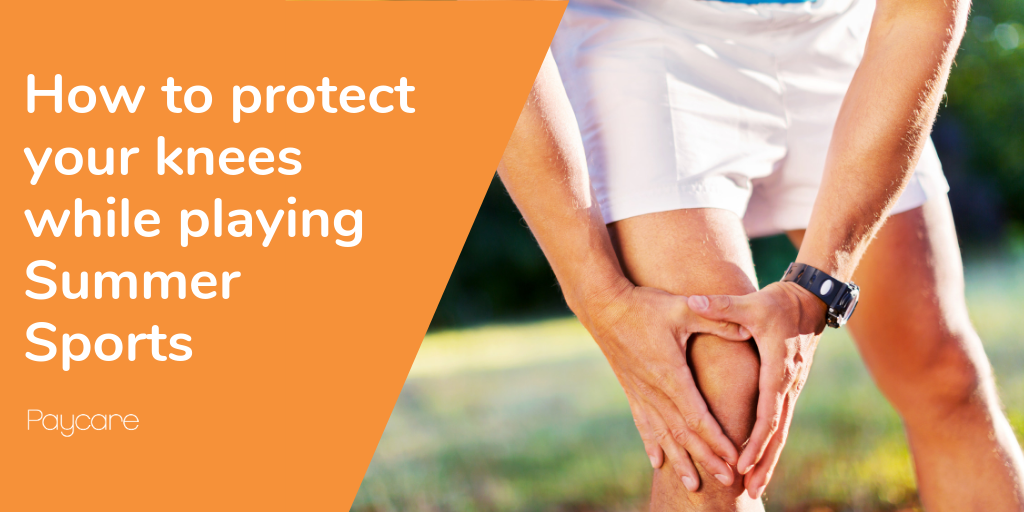We are super excited here at the Paycare office as summer is on the horizon. And, what better way to increase our excitement even more than to begin talking all things summer and the outdoors!
With #NationalWalkingMonth being on May’s agenda and 12 hours of sun and warm weather soon on its way, it’s no wonder we are encouraging everyone to get outside and be more active!
But, where many of us tend to stick to long summer walks (you can’t beat them), some of us find ourselves taking part in more extreme summer sports and physical activity. That’s why, we’ve teamed up with Paycare Partners, Medstars, who have provided us with some great top tips on how you can protect your knees and legs whilst being active and having fun this summer – take a look! 😊
“With the summer season upon us, there’s no better time to get outside and get active. Although we all fancy ourselves as a Federer on the court or a Farah on the track, unlike the pros, a good chunk of us are unaware of the injury risks that come with sport. Doing your best to prevent injury is important, so here’s our guide on how to protect your knees while playing sports this summer.
The warm-up
Before engaging in any exercise, nothing is more important than warming-up and your knees are no exception. Whether you’re playing sport in the sunshine competitively or recreationally, it’s essential to flex and stretch the knee prior to any activity! By stretching and flexing the knee, blood moves around the joint and the muscles, tendons, and ligaments that surround it. This prepares your knee for the movements required during sport and is the best way to prevent injury.
Preparing the muscles
During most summer sports your knees will be the recipient of weight-bearing exercise. This is where your muscles and bones work against gravity through your feet on the ground. Sports such as running, tennis or football are examples of this type of exercise. In order to prepare for these activities it is essential that your hamstrings and quadriceps are stretched to avoid injury. The quadriceps are engaged whenever you extend your knee and the hamstrings allow for your knees to flex and rotate.
Dynamic over static stretching
In order to prevent injury to your knees, dynamic stretching should be a focal point of your warm-up. While static stretching – which involves elongating a muscle and holding it for a period of time – is beneficial after exercise, dynamic stretching of the knee is most appropriate prior to summer sports. This type of stretching involves slow, active movements of the legs, such as lunges, heel flicks, or leg lifts.
Running
First, start by gradually increasing the movement in your legs: begin by walking, then progress into a light jog and continue to build up speed in a slow and controlled manner. You don’t have to go too fast and either slow down or stop entirely should you feel any pain. After about five minutes, try out some dynamic stretches. With all of your dynamic stretches, keep the motions small, increasing the range of the motion with each repetition. Spend two to five minutes on your stretches in total, but don’t worry too much about how long your stretching lasts for, as long as your knees and the muscles around them feel loose and ready to go.
Dynamic stretches
Small lunges are always a good transition exercise from running into stretching. To practice small lunges, place both of your hands on your head, keep your core tight and begin to take small steps forward. As you take each step, drop your trailing knee to within a few centimetres of the floor. Your front leg should be at 90-degrees and your upper body held upright. Repeat this until you have completed between five and 10 steps with each leg.
High-knees is a great way to warm up! Move forward at a slow jogging pace and lift your knees up one at a time to about waist height as you move. Try to be light on your feet and don’t lean back as you lift your knees. If you struggle to get to waist height, don’t worry, just elevate your knees to a comfortable height and repeat. Look to complete this exercise two or three times!
Active rest
Once you’ve finished playing sport, it is essential to treat your knees with care to ensure they’ll be good to go for next time. One way to keep your knees healthy after sport is through non-weight-bearing activity. Swimming laps, riding a bicycle or rowing a rowing machine, are all examples of ways to gently let your joints recover after sport. Not only this, passive yoga poses can be a great way to help out your knees. Many yoga poses affect the muscles around your knees that keep them strong. This helps them to recover and increases their strength for the future.
A touch of cold
Where warming-up your joints before sport is essential, cooling them down afterwards is also important. Applying an ice pack to your knees, or the muscles surrounding them, is one of the most effective ways to calm inflammation and alleviate pain. Hold or rest an ice pack against your knee for at least 20 minutes. If your skin is sensitive or responds negatively to the ice, place a thin cloth or towel between your knee and the ice to reduce the discomfort.”
Wow! Thanks Medstars, some great tips there we can all take away with us this Summer!
It really is important that we take care of our joints and muscles when being active – after all, we don’t want to miss out next time!
Anyway, don’t mind us – we’re off to indulge ourselves into a very competitive game of rounder’s, but first, if we’ve got any chance of winning, we need to do a big warm up!
Until next time… 😊
***
Remember, if you’re a Paycare Policyholder and need to visit a physiotherapist, chiropractor or osteopath due to injury, ageing, disability or a health condition, we’ve got you covered! Just remember, terms and conditions apply to all benefits covered on your plan.
***

Medstars, one of our fantastic Paycare Partners, is a curated community of trusted health professionals.
Their free online booking platform features individual practitioner profiles, displaying expertise, prices, location, availability and patient testimonials to ensure you can make an informed decision and choose the right health professional for you.
For more information, visit www.medstars.co.uk

